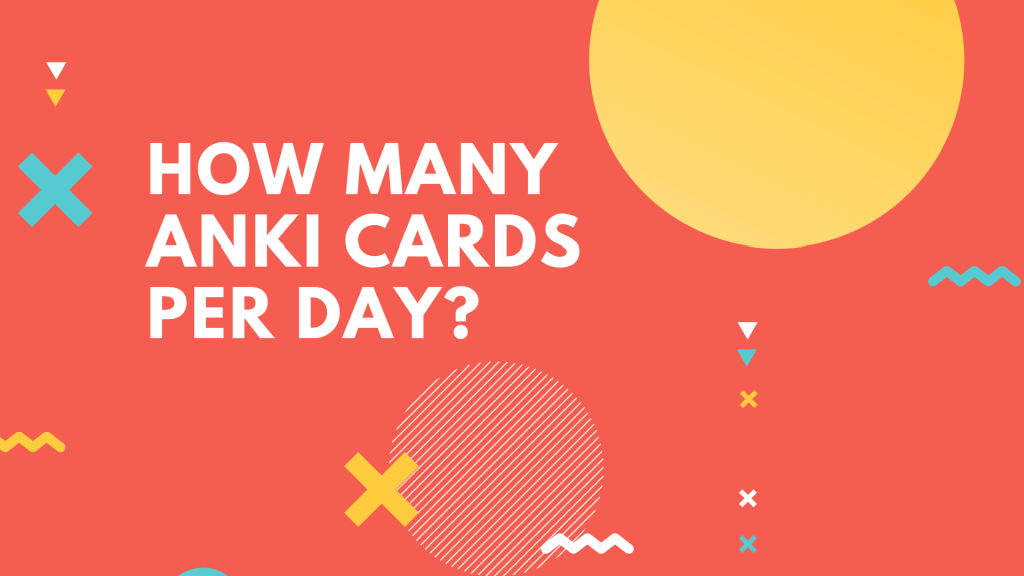How Many Anki Cards per Day Should I Do to be Fluent in a Language
If you are like many other language learners, using Anki is a wonderful tool to help you learn a foreign language. Whether you are a beginner, intermediate or advanced learner, adding new cards per day to your deck can be an activity that you can do to progress in your learning. You might be wondering to yourself: How many Anki cards per day should I do? And how can I make sure that I don’t have an overwhelming number of new Anki cards per day to review?
A rule of thumb for how many Anki cards per day to do is 10 cards per day. It is important to firstly highlight that 10 cards a day isn’t some magic number that you have to follow in order to be successful in using Anki for language learning. It is just a general guideline that we found to work for most people who have used our Speakada flashcards and/or who generally use Anki for language learning.
There are 3 factors to consider to find the right number of cards to make per day for you. Everyone will have different experiences and so finding what works best for you is key. We’ll go in-depth on each factor listed below.
- The amount of time for Anki and your personal schedule
- Maintaining daily card reviews
- Your current language level
The Amount of Time for Anki and Your Personal Schedule
You might find when asking other language learners that the number of cards they review can range from 5 to 50 cards per day. This all depends on the time you have to dedicate in learning a language, more specifically how much time you have to create and review cards on Anki. You may have other responsibilities in life such as work and family commitments that can take away from the time you have everyday to learn a language.
Work out how much time you have to dedicate to create cards on Anki. Generally, you should allocate 3 minutes to create 1 card. So if you have 30 minutes to create cards per day, you’ll be able to create 10 cards per day. If you have 10 minutes per day, you’ll only be able to make 3-4 cards per day.
You can try purchasing a pre-made Anki flashcard deck that will cut time on card creation and allow you to focus on just reviewing cards and making cards as you go along immersing in the language. This is helpful for beginners who are still learning pronunciation, the top 2000 words and grammar.
Maintaining Daily Card Reviews
The Anki SRS (Spaced Repetition System) can be stressful to use because you’ll have a constant responsibility to maintain your learning and keep up with all the cards that accumulate in your review backlog. Card reviews plays a big factor when you are trying to work out how many Anki cards should I do a day. Your goal is to make sure that every day, the number of cards in your Review backlog stays at 0. If you’ve been consistent, and you’ve studied all pending Review cards over the previous days, then it should take about 20 minutes to review all your new Review cards for that day.
It’s important to study your Review cards every day, or as often as you possibly can. The reason is because if you miss a day of reviewing your Anki flashcards, then you’ll have double the load the next day and so on. So, then you’ll have to catch up on your missed reviews later on.
This can make language learning experience stressful, not enjoyable and perhaps result in procrastination or even worse, a negative association to language learning. For the sake of your mental health and not getting too stressed out, select a number of cards that feels right for you and that you are able to manage consistently.
Our suggested 10 new cards per day is a good starting point, but if it’s too much then you could decrease it to 5 flashcards per day. But if you find that you can stay on top of all your Anki reviews a day, then you can increase it to 20 new cards a day. Find the number that suits you, but we suggest starting with adding 10 new Anki cards per day.
For periods of time when you’ve been busy or tired, and you’ve missed your reviews for the previous days, you might even decide to learn 0 new cards for the next few days, until you catch up with all your reviews. This strategy has worked for me as a way to catch up on my reviews, after periods of being busy with work or family.
Your language level
Your current language level will also be a factor to consider when figuring out how many cards you should make per day.
For example, if you are just starting to learn a new language, learning the top 2000 words of any language is a huge task. So starting with a large number of cards can help you get through the most frequent words faster, particularly the top 2000 words. The quicker you are able to retain vocabulary, the quicker you’ll be able to speak in a foreign language.
However if you have already reached an intermediate level, you might find it best to be spending more time engaging with real content in the foreign language, rather than spending all your time making and reviewing cards. This is because there’s a difference between “knowing” a word and having “acquired” the word. There will be a bunch of words in this middle category where you have learned them in Anki and are in your mental word bank but are not activated when you try to speak or engage in the foreign language. Because you already know them intellectually, it may not help you to make more SRS cards related to these words. It’s just a matter of getting more engagement from content that will help you activate the knowledge.
As you become more advanced, the words that you are learning have less value because you have already learned all the most common words that come up all the time and so are really important to learn. Therefore, when considering the number of cards to make as an advanced learner, you might want to consider a lower number than 10 cards per day. This is because you are learning rare words when you are more advanced and so it’s not a good use of your time to be learning those rare words everyday because the benefit of learning those words are so small. Instead, you’re better off spending time immersed in the language by enjoying movies, TV, books, songs and real conversations in the language.
How Many Anki Cards Per Day Should I Do?
Finding the right balance that works for you is key. My suggestion is to start with 10 cards per day and if you find this is manageable and you would like to increase the number of cards per day, try increasing the number by 5 cards for a week, until you reach a number of cards that you feel comfortable with and that works with your schedule.
I personally aim to have 10 cards per day. The reason why I ended up settling for 10 cards a day is because after experimenting with the number of cards to review, that’s the one that felt the best. It was through doing 10 cards a day that I was able to obtain a passable vocabulary that was larger than most native speakers. But at the same time it didn’t feel that much day to day.
The number of card reviews never got too big and I never had to spend too much per day on cards so it overall worked well. Of course I had the idea to do more and I was originally trying to do 15 or 20 a day but felt that was too much. It takes a lot of time to make cards, especially if you are making monolingual cards. When you are making 15 to 20 flashcards a day and keeping up with the reviews, it is a lot of time and effort. You’ll need to balance the time you have for Anki and for language immersion (reading, watching, speaking, and listening to native-speaker material).
To ensure that you do not have an overwhelming amount of cards to review, try a lower number of cards per day. 10 cards per day is a great number to start with as it is a substantial amount of cards. When you think about it, it’s hundreds of cards a month, thousands of cards a year. To be specific, if you learned 10 new cards per day, which consisted of 10 new words, then you would learn 3650 new words per year! If you continued doing this every year, then over time your vocabulary in that language would grow to tens of thousands of words. This should be your goal, as native speakers in a language have an active and passive vocabulary in the tens of thousands of words.
As long as you are learning at a steady pace and consistently then it’s okay not to do so many a day because you’ll get there eventually. Remember, you don’t need to stick with the same number of cards forever, it is something that will continue to change as you progress. There are a few factors to consider when you are trying to figure out how many Anki cards per day you should do. All things considered whether you are a beginner or advanced learner, learning 10 cards a day is by no means a small amount, it is a lot more than creating 5 cards a day but it is still very doable.










